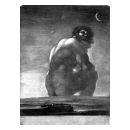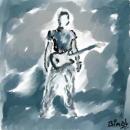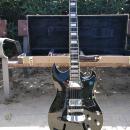he encontrado esta review de los teclados cme en keyboard magazine, lo mismo os interesa a alguien:
-----------------------------------------------------------------------------------------------------------
CME UF8 USB MIDI Controller Keyboard
By Craig Anderton | April 2005
The place: The Music China 2004 show, in Shanghai, China. Among the zillions of mics and mixers, there was a line of spiffy-looking USB keyboards. They weren’t knockoffs, they neither felt nor looked cheap, and they had a ton of controls. I checked out the keybed — hmmm, serious stuff.
I asked CME’s representative about the 88-note model’s price. He quoted a figure so low I thought we were dealing with a language barrier issue. Maybe he meant what it cost to make.
Fast forward to NAMM 2005, where CME’s keyboards made their US debut. About the price: let’s just say his English was perfect.
So is this the new wave of Chinese manufacturing, or had significant corners been cut? I had to find out . . . and Keyboard Central wanted to know too.
The Shake Test
I’m not adverse to a little product abuse when testing reliability. But in a considerate move, UPS did that for me: The box looked like it had been beaten with baseball bats. The styrofoam spacers were crushed, and when I removed the keyboard, something was rolling around inside. I strongly doubted the thing had survived . . . but it did.
Installation
The package includes the keyboard, “line lump” AC adapter, sustain pedal, installation CD, USB cable, and manual — in Chinese. Luckily, the web site had an English language PDF, and an updated driver.
The driver wouldn’t install under Windows XP, but worked perfectly with the XP + Service Pack 1 combo. For the Mac, the keyboard installed as expected with the OS X 2.x drivers.
However, you’re not restricted to using USB; there’s a MIDI out jack for blasting data into a standard MIDI interface.
Overview
The case is sheet aluminum with plastic end bells and trim, and weighs a bit over 50 lbs. — not bad. The action is weighted, and the keybed feels really good: just the right amount of resistance on key-down and “bounce back” on the release. The key-to-key consistency is spot on too. Hitting a key with the same subjective dynamics produced the same velocity value.
There’s no programmable velocity curve, although there are four presets. Linear produces the most dynamic effect. Another weights the curve so that you get into higher velocities sooner — useful for triggering bass and drum parts for more uniform levels. The third curve weights everything toward high velocity, which is ideal for emulating the lack of dynamics with organs and such. The final “S” curve stays at low velocities, then transitions fairly quickly to high velocities — good for essentially keyswitching between samples assigned to low and high velocities. The rear panel is Spartan: MIDI out, sustain pedal jack, controller pedal jack and breath control jack (both assignable to your controller number of choice), USB port, AC adapter jack, power on-off switch, and a cable hook to provide strain relief as well as minimize the odds of pulling out the AC adapter jack accidentally. There’s also an expansion slot for a FireWire audio interface, which was not yet available at the time of this review.
Controllers
You like knobs? There are eight assignable knobs, eight assignable 45mm faders, a master volume control that edits “expression” with GM standard devices, and sequencer transport controls.
The faders have three defaults: volume for MIDI channels 1-8, the same for channels 9-16, and “drawbar” mode (supported by some instruments and software). The eight knobs tie default controller settings into GM parameters, but knob and fader assignments are very easy to change.
Cleverly, with a fader or knob at minimum, the display shows 000 for a bit, then shows the program number and the Program button lights up. You can then change the program by spinning the data wheel. It’s cool that when the volume is down, you automatically have the option to do something that you would likely do with the volume down.
As to feel, the knobs are center detented. While welcome for panning and controllers that go ± compared to a base value, for smooth sweeps the detent gets in the way a bit — so use the faders for that. However, they do have a smooth, well-oiled feel (I observed MIDI data in Creamware’s MIDI Monitor, and noted no jitter — just a smooth progression from one value to the next). They’re kinda close together, though; instead of mounting them in a straight line, I would have preferred to see two offset knob groups.
The Big Honkin’ Data Wheel That Looks Like a UFO is just a knob that’s ringed with LEDs. But it looks cool, and when the internal demo sequence is going, the lights fly around the knob. Whee!
The transport buttons were a bit of a letdown; pressing the record button showed some sys-ex, so I used that with Sonar’s Generic Control Surface to control the play button . . . but didn’t get much further. I checked whether the buttons emulated several popular control surfaces but again, no luck. Nor did they seem to transmit MTC. I suspect these buttons have to be specifically supported in software, like other control surfaces. Indeed, CME reports that they’re working on a software update that includes templates.
In Use
While reviewing the UF8, I was also reviewing IK Multimedia’s Sonik Synth 2 for EQ. The two made a great pair — I had all the keyboard needed to check out the patches (particularly the pianos and other wide-range sounds), and took advantage of the UF8’s split/layer and program selection options.
I also appreciated the ease of assigning controllers for realtime parameter tweaks. And even though you can’t assign aftertouch as a controller within Sonik Synth 2’s engine (although an upgrade is imminent, I’m told), several patches are programmed for aftertouch “under the hood” and showed off the keyboard’s smooth aftertouch response.
Conclusions
CME has indeed met their goal of producing a USB master keyboard that’s strong, cost-effective, and feels great. It’s not the first aluminum master keyboard, but I get their point: In a world of plastic USB controllers, this is a different animal.
I do wish it had polyphonic aftertouch. I know that’s not a big deal for most people, but I keep my Ensoniq keyboards around for that feature — and anything that makes a keyboard more expressive is welcome. Still, quality channel aftertouch is way better than nothing.
Did I “fall in love” with it? Well, that’s a bit flowery. But I have to admit that when I played it, my first thought was “Wow, I’d like to buy this.” When I found out the price, that changed to “I’m going to buy this.” And I am. I’ve put up with five-octave, unweighted plastic keys for too long . . . it’s time to upgrade, and for me the UF8 is the right product, at the right time, for the right price.
Overview
Pros:
Surprising quality, especially given the price. Great feel, with weighted keys and consistent aftertouch. Sturdy. Lots of easily-assignable controls. FireWire audio interface option.
Cons
Only one split/layer. No polyphonic aftertouch.
Mono aftertouch provides a control signal that affects all notes being played on the keyboad. Pressing harder increases the amount of this control signal. With polyphonic aftertouch, which is far less common, each key generates its own signal. Aftertouch is often used to alter filter cutoff or some other modulation amount.
Claim Check
CME says that the UF series is the most cost-effective master keyboard available, and claims several “world firsts”: metal construction MIDI master keyboard, digital audio firewire expansion option, breath control, and aftertouch on all their controllers, from 49 to 88 keys. Their web site also says that the first moment you touch UF, you will “fall in love” with it, thanks to the action.
Vital Stats
Software driver version
1.0.1
Computer requirements
Mac: OS X 10.2 or higher; Windows XP: with Service Pack 1
Keyboard
88 keys with weighted action and channel aftertouch
Controllers
8 assignable knobs, 9 assignable faders, mod wheel, pitch bend wheel, velocity with four switchable curves, jacks for sustain pedal, volume pedal, breath control
Octave Switch
±3 octaves
Sequencer control
Record, stop, play, fast forward, rewind, return to zero
Display
3-digit, seven-segment LEDs; lit switches
Expansion Options
FireWire audio interface
Power Source
USB, AC adapter (required for aftertouch and use of breath control jack)
-------------------------------------------------------------------------------------------------
http://www.keyboardmag.com/story.asp?se ... ycode=7780
saludos
















